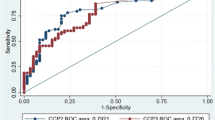Abstract
Anti-citrullinated protein/peptide antibodies (ACPAs) have recently been identified as sensitive and specific diagnostic and prognostic markers in rheumatoid arthritis (RA). In this study, we wished to assess the diagnostic performance of the third-generation anti-CCP3.1 assay, but with special focus on the rheumatoid factor (RF)-negative RA population. Anti-CCP as well as anti-MCV was tested in 119 RA patients and 118 control patients using second and third-generation assays. Using these optimal cut-off levels, the diagnostic sensitivity of anti-CCP2, CCP3, and CCP3.1 was 74.8, 78.8, and 83.0 %, respectively, while the specificity was 95.7, 96.6, and 98.3 %, respectively. The diagnostic performance of the CCP3.1 test was significantly better than that of CCP2 (p = 0.041). In addition, the CCP3.1 test performed significantly better than the MCV test as well (p = 0.0003). When the diagnostic performance of the CCP3.1, CCP2, and MCV tests was compared in the 35 RF-negative patients, the CCP3.1 test exerted significantly better performance than the MCV test (p = 0.006), and it also showed a tendency of better performance in comparison with the CCP2 test (p = 0.131). In conclusion, the CCP3.1 assay can significantly increase the sensitivity of ACPA testing in RF-negative RA, as well as in the total RA population.



Similar content being viewed by others
References
Alamanos Y, Drosos AA. Epidemiology of adult rheumatoid arthritis. Autoimmun Rev. 2005;4(3):130–6.
Szodoray P, Szabo Z, Kapitany A, Gyetvai A, Lakos G, Szanto S, et al. Anti-citrullinated protein/peptide autoantibodies in association with genetic and environmental factors as indicators of disease outcome in rheumatoid arthritis. Autoimmun Rev. 2010;9(3):140–3.
Cooles FA, Isaacs JD. Pathophysiology of rheumatoid arthritis. Curr Opin Rheumatol. 2011;23(3):233–40.
Besenyei T, Gyetvai A, Szabo Z, Fekete A, Kapitany A, Szodoray P, et al. Associations of HLA-shared epitope, anti-citrullinated peptide antibodies and lifestyle-related factors in Hungarian patients with rheumatoid arthritis: data from the first Central-Eastern European cohort. Joint Bone Spine. 2011;78(6):652–3.
Schellekens GA, Visser H, de Jong BA, van den Hoogen FH, Hazes JM, Breedveld FC, et al. The diagnostic properties of rheumatoid arthritis antibodies recognizing a cyclic citrullinated peptide. Arthritis Rheum. 2000;43(1):155–63.
Aletaha D, Neogi T, Silman AJ, Funovits J, Felson DT, Bingham CO 3rd, et al. 2010 rheumatoid arthritis classification criteria: an American College of Rheumatology/European League against Rheumatism collaborative initiative. Ann Rheum Dis. 2010;69(9):1580–8.
Klareskog L, Padyukov L, Lorentzen J, Alfredsson L. Mechanisms of disease: genetic susceptibility and environmental triggers in the development of rheumatoid arthritis. Nat Clin Pract Rheumatol. 2006;2(8):425–33.
Klareskog L, Widhe M, Hermansson M, Ronnelid J. Antibodies to citrullinated proteins in arthritis: pathology and promise. Curr Opin Rheumatol. 2008;20(3):300–5.
Szekanecz Z, Soos L, Szabo Z, Fekete A, Kapitany A, Vegvari A, et al. Anti-citrullinated protein antibodies in rheumatoid arthritis: as good as it gets? Clin Rev Allergy Immunol. 2008;34(1):26–31.
van Venrooij WJ, Zendman AJ, Pruijn GJ. Autoantibodies to citrullinated antigens in (early) rheumatoid arthritis. Autoimmun Rev. 2006;6(1):37–41.
Lakos G, Soos L, Fekete A, Szabo Z, Zeher M, Horvath IF, et al. Anti-cyclic citrullinated peptide antibody isotypes in rheumatoid arthritis: association with disease duration, rheumatoid factor production and the presence of shared epitope. Clin Exp Rheumatol. 2008;26(2):253–60.
dos Anjos LM, Pereira IA, d’Orsi E, Seaman AP, Burlingame RW, Morato EF. A comparative study of IgG second- and third-generation anti-cyclic citrullinated peptide (CCP) ELISAs and their combination with IgA third-generation CCP ELISA for the diagnosis of rheumatoid arthritis. Clin Rheumatol. 2009;28(2):153–8.
Arnett FC, Edworthy SM, Bloch DA, McShane DJ, Fries JF, Cooper NS, et al. The American Rheumatism Association 1987 revised criteria for the classification of rheumatoid arthritis. Arthritis Rheum. 1988;31(3):315–24.
Szekanecz Z, Szabó Z, Soós L, Zeher M, Horváth IF, Dankó K, Sipka S, Lakos G. The Inova CCP3.1 IgA/IgG ELISA represents significant improvement in the laboratory diagnosis of rheumatoid arthritis. Arthritis Rheum. 2007;56(9 Suppl):S716.
Szekanecz ZTJ, Szabó Z, Soós L, Zeher M, Horváth IF, Dankó K, Sipka S, Lakos G. The Inova CCP3.1 IgA/IgG ELISA represents significant improvement in the laboratory diagnosis of rheumatoid arthritis. Ann Rheum Dis. 2008;67(Suppl II):568.
Bartoloni E, Alunno A, Bistoni O, Bizzaro N, Migliorini P, Morozzi G, Doria A, Mathieu A, Lotzniker M, Allegri F, Riccieri V, Alpini C, Gabrielli A, Tampoia M, Gerli R. Forum Interdisciplinare per la Ricerca nelle Malattie Autoimmuni (FIRMA) investigators. Diagnostic value of anti-mutated citrullinated vimentin in comparison to anti-cyclic citrullinated peptide and anti-viral citrullinated peptide 2 antibodies in rheumatoid arthritis: an Italian multicentric study and review of the literature. Autoimmun Rev. 2012;11:815–20.
Mutlu N, Bicakcigil M, Tasan DA, Kaya A, Yavuz S, Ozden AI. Comparative performance analysis of 4 different anti-citrullinated protein assays in the diagnosis of rheumatoid arthritis. J Rheumatol. 2009;36:491–500.
Debaugnies F, Servais G, Badot V, Noubouossie D, Willems D, Corazza F. Anti-cyclic citrullinated peptide antibodies: a comparison of different assays for the diagnosis of rheumatoid arthritis. Scand J Rheumatol. 2012 Nov 6. (Epub ahead of print).
Acknowledgments
This work was supported by research grants ETT 315/2009 from the Medical Research Council of Hungary (Z.S.); OTKA K 105073 from the National Scientific Research Fund of Hungary (Z.S.), and by the TÁMOP 4.2.1/B-09/1/KONV-2010-0007 and 4.2.2.A-1/11/KONV-2012-0031 projects co-financed by the European Union and the European Social Fund (Z.S.).
Author information
Authors and Affiliations
Corresponding author
Rights and permissions
About this article
Cite this article
Szekanecz, Z., Szabó, Z., Zeher, M. et al. Superior performance of the CCP3.1 test compared to CCP2 and MCV in the rheumatoid factor-negative RA population. Immunol Res 56, 439–443 (2013). https://doi.org/10.1007/s12026-013-8425-8
Published:
Issue Date:
DOI: https://doi.org/10.1007/s12026-013-8425-8




